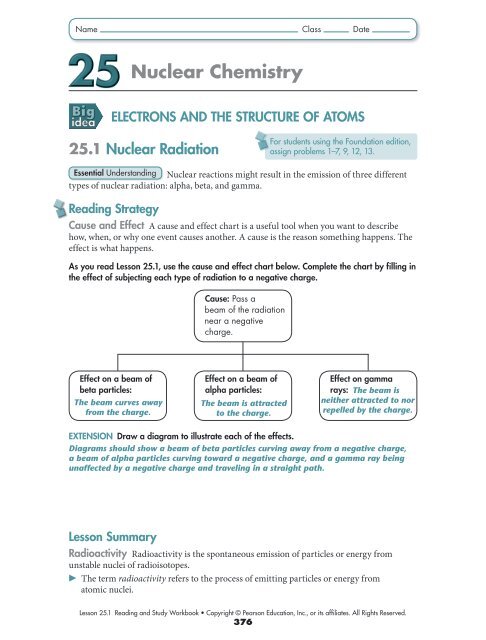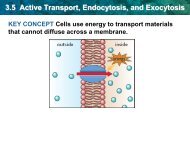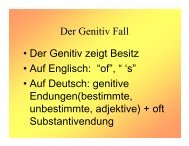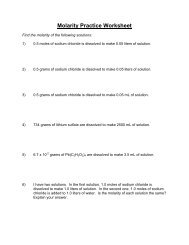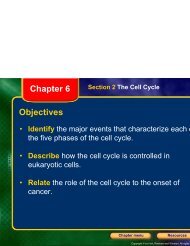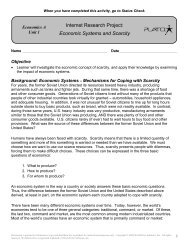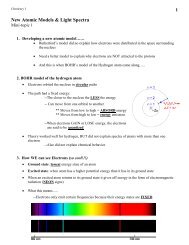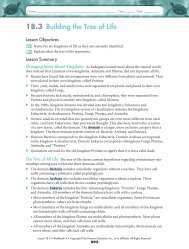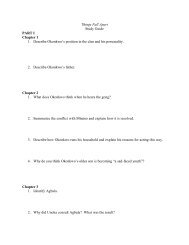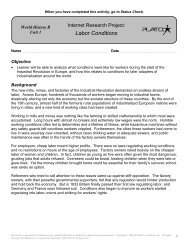Nuclear Chemistry - Lake Central High School
Nuclear Chemistry - Lake Central High School
Nuclear Chemistry - Lake Central High School
- No tags were found...
Create successful ePaper yourself
Turn your PDF publications into a flip-book with our unique Google optimized e-Paper software.
Name Class Date<strong>Nuclear</strong> <strong>Chemistry</strong>ELECTRONS AND THE STRUCTURE OF ATOMS25.1 <strong>Nuclear</strong> RadiationFor students using the Foundation edition,assign problems 1–7, 9, 12, 13.Essential Understanding <strong>Nuclear</strong> reactions might result in the emission of three differenttypes of nuclear radiation: alpha, beta, and gamma.Reading StrategyCause and Effect A cause and effect chart is a useful tool when you want to describehow, when, or why one event causes another. A cause is the reason something happens. Theeffect is what happens.As you read Lesson 25.1, use the cause and effect chart below. Complete the chart by filling inthe effect of subjecting each type of radiation to a negative charge.Cause: Pass abeam of the radiationnear a negativecharge.Effect on a beam ofbeta particles:The beam curves awayfrom the charge.Effect on a beam ofalpha particles:The beam is attractedto the charge.Effect on gammarays: The beam isneither attracted to norrepelled by the charge.EXTENSION Draw a diagram to illustrate each of the effects.Diagrams should show a beam of beta particles curving away from a negative charge,a beam of alpha particles curving toward a negative charge, and a gamma ray beingunaffected by a negative charge and traveling in a straight path.Lesson SummaryRadioactivity Radioactivity is the spontaneous emission of particles or energy fromunstable nuclei of radioisotopes.▶▶The term radioactivity refers to the process of emitting particles or energy fromatomic nuclei.Lesson 25.1 Reading and Study Workbook • Copyright © Pearson Education, Inc., or its affiliates. All Rights Reserved.376
Name Class Date▶▶ The particles or energy emitted during radioactivity is called nuclear radiation.▶▶ <strong>Nuclear</strong> reactions are not affected by factors such as temperature, and their rate cannotbe changed.Types of Radiation There are three types of radiation emitted by nuclear reactions.▶▶ Alpha particles are helium nuclei, each of which contains two protons and two neutrons.▶▶ Beta particles are electrons formed when a neutron breaks down into a proton and abeta particle.▶▶ A gamma ray is a high-energy photon that is often emitted along with an alpha particleor a beta particle.After reading Lesson 25.1, answer the following questions.Radioactivity1. Which French chemist noticed that uranium salts could fog photographic plates, evenwithout being exposed to sunlight? Antoine Henri Becquerel2. What name did Marie Curie give to the process by which materials give off rays capableof fogging photographic plates? radioactivity3. An isotope that has an unstable nucleus is called a(n) radioisotope .4. Complete the table below to show basic differences between chemical and nuclearreactions.Type of reaction Is nucleus of atom changed? Is reaction affected bytemperature, pressure, orcatalysts?Chemical<strong>Nuclear</strong>noyesyesno5. Complete the flowchart below, which describes the radioactive decay process.The presence of too many or too few neutronsan unstable nucleus.relative to protons leads toAt some point in time, an unstable nucleus will undergo a reaction and lose energy byemitting radiation.During the process of radioactive decay, a(n) unstableone element is transformed eventually into a(n) stabledifferent element.radioisotope ofisotope of aLesson 25.1 Reading and Study Workbook • Copyright © Pearson Education, Inc., or its affiliates. All Rights Reserved.377
Name Class DateTypes of Radiation6. Complete the following table showing some characteristics of the main types ofradiation commonly emitted during radioactive decay.TypeAlpha particleBeta particleGamma radiationConsists of2 protons and2 neutronselectronhigh-energyelectromagneticradiationMass (amu)4______ 11837 0Penetrating power(low, moderate, orhigh)lowmoderatehighMinimum shieldingsheet of papermetal foilthick concreteor lead7. Look at Figure 25.2. It shows the alpha decay of uranium-238 to thorium-234.a. What is the change in atomic number after the alpha decay?It decreases by 2.b. What is the change in mass number after the alpha decay?It decreases by 4.8. When are radioisotopes that emit alpha particles dangerous to soft tissues?These radioisotopes are dangerous when they are ingested.9. Look at Figure 25.3. This diagram shows the beta decay of carbon-14 to nitrogen-14.a. What is the change in atomic number after the beta decay?It increases by 1.b. Which quantity changes in beta decay, the mass number or the charge of the nucleus?the charge of the nucleus10. Explain how gamma radiation is similar to visible light, and how it is different.Similar: Both are forms of electromagnetic radiation.Different: Gamma radiation has much higher energy than visible light.11. When are gamma rays emitted?Gamma rays are often emitted along with alpha or beta particles by the nuclei ofdisintegrating atoms.12. Is the following sentence true or false? Gamma rays have no mass and no electricalcharge. trueLesson 25.1 Reading and Study Workbook • Copyright © Pearson Education, Inc., or its affiliates. All Rights Reserved.378
Name Class Date13. Look at the diagram below. Below each material indicate with a checkmark which typeof radiation—alpha, beta, or gamma—can be stopped by each material.Lead blockPaper Wood Lead or concreteRadioactivesource alpha alpha alpha beta beta beta gamma gamma gamma25.2 <strong>Nuclear</strong> TransformationsFor students using the Foundationedition, assign problems 1–13, 16.Essential Understanding <strong>Nuclear</strong> transformations are changes in the nuclei of radioisotopeswhen they decay.Lesson Summary<strong>Nuclear</strong> Stability and Decay Most known nuclei are not stable and will decayover time.▶▶ The nuclear force is a force that holds together all the particles in a nucleus.▶▶ The neutron-to-proton ratio determines the stability of an isotope and the type of decayit will undergo.▶▶ Unstable nuclei might undergo beta emission, electron capture, positron emission, oralpha emission.Half-Life Half-life is a measure of how quickly an element undergoes nuclear decay.▶▶ At the end of one half-life, half of a sample of radioactive atoms have decayed into anew element.▶▶ Half-lives range from a second to billions of years.▶▶ Radioisotopes with long half-lives are used to date objects or materials, and isotopes withshort half-lives have medical uses.Transmutation Reactions During a transmutation reaction, one element changes intoanother element.▶▶ Transmutation can occur during radioactive decay.▶▶ Transmutation also can occur when protons, neutrons, or alpha particles bombardatomic nuclei.▶▶ All elements with an atomic number greater than 92 are called transuranium elementsand undergo transmutation.Lesson 25.2 Reading and Study Workbook • Copyright © Pearson Education, Inc., or its affiliates. All Rights Reserved.379
Name Class DateBUILD Math SkillsUsing Scientific Notation Often in chemistry we come across anumber that is very large. Scientific notation is a way to express verylarge numbers in a simpler, smaller notation.Scientific notation is expressed with a coefficient that is alwaysgreater than 1 but less than 10. This number is multiplied by the“base,” which is always equal to 10, with some given exponent.For example, the speed of light is 300,000,000 m/sec. Expressedin scientific notation, it is: 3.0 × 10 8 m/sec.To write a number in scientific notation, follow these simple steps:▶▶ Place a decimal after the first non-zero digit of the number, and cut off the zeros. (If it isa single digit such as the 3 in the speed of light above, leave one zero after the decimal.)This is the coefficient.▶▶ Count the number of places from the decimal point in the original number to thedecimal you added in the coefficient. This is the exponent.The exponent does have a sign associated with it. If the number is greater than 1, theexponent is positive. If the number is less than 1, the exponent is negative.Sample Problem Express the following number in scientific notation: 0.000000245.First, place a decimal after thefirst non-zero digit of the number.In this case, the first non-zerodigit is 2.00000002.45Next, cut off the zeros. That givesyou the coefficient.00000002.45 → 00000002.45Coefficient = 2.45Now count, in the originalnumber, how many places it takesto get from the original decimalpoint to the decimal point in thecoefficient.Finally, express the numberin scientific notation using thecoefficient and exponent.It takes 7 places to get from the originaldecimal point to the decimal of thecoefficient. Since the number is lessthan 1, the exponent is negative.Exponent = –7Scientific notation of 0.000000245 →2.45 x 10 -7Hint: Remember that the “base” is alwaysequal to 10. The only things that changeare the coefficient and the exponent.Lesson 25.2 Reading and Study Workbook • Copyright © Pearson Education, Inc., or its affiliates. All Rights Reserved.380
Name Class DateNow it’s your turn to practice converting numbers to and from scientific notation. Rememberthat if the number is less than 1, the exponent is negative; if it is greater than 1, the exponentis positive.1. What is 678,000,000,000.0 expressed in scientific notation?6.78 ∙ 10 112. What does the number expressed as 3.62 × 10 –4 look like?0.0003623. What is 4045 expressed in scientific notation?4.045 ∙ 10 34. How would you express 0.00005098 in scientific notation?5.098 ∙ 10 –5 equalAfter reading Lesson 25.2, answer the following questions.<strong>Nuclear</strong> Stability and Decay5. Of the more than 1500 different nuclei that are known to exist, about what portion arestable?a. 1 of 10 b. 1 of 6 c. 1 of 3 d. 1 of 26. For elements with low atomic numbers, stable nuclei have roughlynumbers of neutrons and protons.7. Look at Figure 25.6. How does the ratio of neutrons to protons for stable nuclei change asan atomic number increases from 1 to 82?The ratio of neutrons to protons increases from 1 to about 1.5.8. A positron has the mass of a(n) electron, but its charge ispositive.9. Complete the table below showing changes in charge and number of neutrons andprotons for different types of nuclear decay.Reason nucleus isunstableType of decayChange in nuclearchargeChange in number ofprotons and neutronsToo many neutronsBeta emission∙1p increases by 1n decreases by 1Too many protonsElectron capture−1p decreases by 1n increases by 1Too many protonsPositron emission−1p decreases by 1n increases by 1Too many protonsand neutronsAlpha emission−2p decreases by 2n decreases by 2Lesson 25.2 Reading and Study Workbook • Copyright © Pearson Education, Inc., or its affiliates. All Rights Reserved.381
Name Class DateHalf-Life10 . What is half-life?the time it takes for half of the nuclei in a radioactive sample to decay11. Look at Table 25.2 to help you answer the following questions.a. What is the half-life in years of carbon-14? 5.73 ∙ 10 3 yearsb. How many years old is an artifact that contains 50% of its original carbon-14?An artifact that contains 25% of its original carbon-14?5730 years; 11,460 yearsc. What radiation is emitted when potassium-40 decays?Beta particles and gamma rays are emitted.d. What is the half-life of potassium-40? 1.25 ∙ 10 9 yearse. Which isotopes listed in Table 25.2 have a half-life similar to that of potassium-40?uranium-235 and uranium-23812 . The decay reaction below shows how a radioactive form of potassium found in manyminerals decays into argon (gas). Fill in the missing mass number and atomic numberfor the argon isotope that results from the decay of potassium-40.+4040 019 K –1 e Ar18Transmutation Reactions13. The conversion of an atom of one element to an atom of another element is calledtransmutation .14. What are two ways transmutation can occur?It can occur by radioactive decay or by bombardment of the nucleus of an atom witha high-energy particle.15. Uranium-238 undergoes 14 transmutations before it reaches a stable isotope oflead-206.16. Is the following sentence true or false? All transuranium elements were synthesized innuclear reactors and accelerators. trueLesson 25.2 Reading and Study Workbook • Copyright © Pearson Education, Inc., or its affiliates. All Rights Reserved.382
Name Class Date25.3 Fission and FusionFor students using the Foundation edition,assign problems 1–7.Essential Understanding When a nucleus is bombarded by particles, it can split in nuclearfission or combine in nuclear fusion.Lesson Summary<strong>Nuclear</strong> Fission During nuclear fission, a large nucleus splits into smaller pieces, andlarge amounts of energy are released.▶▶ Some neutrons emitted during fission cause other atoms to break apart, causing achain reaction.▶▶ The rate at which fission occurs can be controlled by neutron moderation and neutronabsorption.▶▶ Used fuel rods create nuclear waste, and storage of this waste over a long period of timeis a problem.<strong>Nuclear</strong> Fusion During nuclear fusion, small nuclei join to form a larger nucleus.▶▶ <strong>Nuclear</strong> fusion of hydrogen atoms, forming helium atoms, is the source of energy inthe sun.▶▶ Fusion reactions release much more energy than fission reactions do.▶▶ Currently, fusion reactions have no practical uses because of the high temperaturesneeded for the reactions to occur.After reading Lesson 25.3, answer the following questions.<strong>Nuclear</strong> Fission1. When certain heavy isotopes are bombarded with neutrons, they split intosmaller fragments.2. Use the following labels to complete the diagram below: fission, fission fragments, andneutrons/chain reaction.neutrons/chain reactionfissionKrypton-9191Kr36Energyfission fragments23592 UUranium-235(fissionable)23692 UUranium-236(very unstable)14256 BaBarium-1423. The uncontrolled fission of 1 kg of uranium-235 can release energy equal to20,000tons of dynamite.Lesson 25.3 Reading and Study Workbook • Copyright © Pearson Education, Inc., or its affiliates. All Rights Reserved.383
Name Class Date4. Look at Figure 25.12. This figure shows the basic components of a nuclear power reactor.a. What part of the reactor contains the nuclear fuel?The fuel rods contain the nuclear fuel.b. What are the two parts of the reactor that control the fission reaction, one by reducingthe speed of neutrons, the other by absorbing neutrons?These parts are the moderator and the control rods.c. What is the role of the coolant?The coolant removes heat from the reactor core. The heat is used to generate steam.5. Which parts of a nuclear reactor must be removed and replaced periodically?fuel rods6. Look at Figure 25.13. Where are spent fuel rods stored in a typical nuclear power plant?They are stored in racks at the bottom of a pool.<strong>Nuclear</strong> Fusion7. Look at Figure 25.14. What happens to each pair of hydrogen nuclei during nuclearfusion?They combine and produce two positrons and a helium nucleus, with the release ofenergy.8. What problem has prevented the practical use of nuclear fusion?The temperatures required to start a fusion reaction make it difficult to contain andcontrol.25.4 Radiation inYour LifeFor students using the Foundation edition,assign problems 2, 4.Essential Understanding Radioactivity can be detected using several means, and there areseveral practical applications of radioactivity.Lesson SummaryDetecting Radiation Radioactivity detection is necessary to prevent undesired effectsof radiation.▶▶ Radiation emitted by radioisotopes has the ability to ionize matter, so it is called ionizingradiation.▶▶ Ionizing radiation can be detected because of its effect on the materials in the detector.▶▶ Instruments used to detect radiation include Geiger counters, scintillation counters, andfilm badges.Lesson 25.4 Reading and Study Workbook • Copyright © Pearson Education, Inc., or its affiliates. All Rights Reserved.384
Name Class DateUsing Radiation Radioisotopes have many practical uses.▶▶ Radiation can be used to analyze the elements in matter, which has forensic and otherapplications.▶▶ Radioactive tracers are used to detect the effects of pesticides and fertilizers on plantsand on animals that eat the plants.▶▶ Medical applications of radioisotopes include detecting and treating certain diseasesand disorders.After reading Lesson 25.4, answer the following questions.Detecting Radiation1. Why are beta particles called ionizing radiation?They have enough energy to knock electrons off some atoms of the bombardedsubstance to produce ions.2. A device that detects flashes of light after ionizing radiation strikes a specially coatedphosphor surface is called a scintillation counter.Using Radiation3. How is neutron activation analysis used?It can be used to detect trace elements in a sample.4. Look at Figure 25.18. How is radioactive iodine-131 being used as a diagnostic tool?Doctors can diagnose thyroid conditions from scanned images because iodine-131 isabsorbed by the thyroid gland.Guided Practice ProblemsAnswer the following questions about Practice Problem 9.7. Manganese-56 is a beta emitter with a half-life of 2.6 h. What is the mass ofmanganese-56 in a 1.0-mg sample of the isotope at the end of 10.4 h?AnalyzeStep 1. What are the known values?(t 1 ) = 2.6 h, initial mass = 1.0 mg; elapsed time = 10.4 h__2Step 2. How many half-lives have passed during the elapsed time?elapsed timenumber of half-lives = ___________t= ____________10.4 h __ 1 2.6 h/half-life 4 half-lives2Practice Problems Reading and Study Workbook • Copyright © Pearson Education, Inc., or its affiliates. All Rights Reserved.385
Name Class DateCalculateStep 3. Multiply the initial mass by 2 1__ for each half-life.1.0 mg × 1__2 ∙ 1__ 2 ∙ 1__ 2 ∙ 1__ 2 = 0.063 mg Mn-56EvaluateStep 4. How do you know your answer is correct?The mass remaining after four half-lives should be much smaller than the original mass.Answer the following questions about Practice Problem 10.8. Thorium-234 has a half-life of 24.1 days. Will all the thorium atoms in a sample decay in48.2 days? Explain.Step 1. How many half-lives have passedin 48.2 days?48.2 days __________________ =24.1 days/half-life2half-livesStep 2. What fraction of the thorium willremain after 48.2 days? 1__2 ∙ 1__ 2 = 1__ 4 Step 3. Will all the thorium decay in48.2 days? Explain.No; one-fourth of the original mass remains.Write at least three summary sentences that explain why each particle in an atom isimportant in reactions, and in what type of reaction it is important. Use the followingsentence format, choose the correct term and then complete the sentence. If a particle isimportant in both types of reactions, write a sentence for both types.A(n) [proton, neutron, electron] is important in a [chemical,nuclear] reaction because…Sample answer: A proton is important in a nuclear reaction because the number ofprotons in a nucleus changes during a transmutation, creating a different element.A neutron is important in a nuclear reaction because neutrons can break down into a protonand a beta particle during a transmutation, and neutrons can cause a chain reaction.An electron is important in a chemical reaction because chemical reactions are the resultof atoms sharing or transferring electrons.Practice Problems Reading and Study Workbook • Copyright © Pearson Education, Inc., or its affiliates. All Rights Reserved.386
Name Class Date25 Self-Check ActivityFor Questions 1–10, complete each statement by writing the correct word or words. If youneed help, you can go online.25.1 <strong>Nuclear</strong> Radiation1. <strong>Nuclear</strong>reactions are not affected by external factors, such as temperatureand pressure, and their rates cannot be changed.2. The three types of nuclear radiation are alpharadiation,betaradiation, and gammaradiation.25.2 <strong>Nuclear</strong> Transformations3. The type of decay that occurs in a radioisotope is determined by itsneutron-to-protonratio.4. After one half-lifeof a radioactive element, half of the original radioactivematerial remains.5. Transmutation can occur by bombarding the nucleus or by radioactive decay.25.3 Fission and Fusion6. In a(n) chain reaction, particles released from one nuclear reactioncollide with other particles and cause more nuclear reactions.7. In fusionreactions, small nuclei combine, producing a larger nucleusand releasing large amounts of energy.8. In fissionreactions, large nuclei split, forming smaller nuclei.25.4 Radiation in Your Life9. Three instruments used to detect radiation are Geiger counters, scintillationcounters, and filmbadges.10. Radioisotopes are used to both diagnoseand treat medical problems.If You Have Trouble With…Question 1 2 3 4 5 6 7 8 9 10See Page 876 877 880 882 885 888 891 891 894 896Self-Check Reading and Study Workbook • Copyright © Pearson Education, Inc., or its affiliates. All Rights Reserved.387
Name Class DateReview Key EquationsSolve the problems. Use the following equation if you need to.A = A 0× ( 1__2 ) n1. The half-life of carbon-14 is 5730 years. Carbon-14 can be used to date objects that are amaximum of about 58,000 years old. Approximately how many half-lives is this?approximately 10 half-lives2. How much carbon-14 is present in a 58,000-year-old skeleton that originally contained456 g of carbon-14? 0.445 gEXTENSION Iodine-131 is used in diagnosing certain medical problems because of its shorthalf-life, which is 8.02 days. Assume a hospital lab uses 4.52 g of iodine-131 in a month.What mass of this radioisotope remains in patients after 32 days?___________________32 days = 4 half-lives; A = 4.52 g ∙ (1__8.02 days/half-life 2 ) 4 = 0.283 gReview VocabularyUse the clues to complete the puzzle. Some of the terms in the puzzle are more than oneword. Then write a clue for the term in the outlined squares.1.N U C L E A R F O R C E2.3.TR4.RAHADANILSOFMILUSITOFATETOIPOEN5. R A D I O A C T I V I T Y6. I O N I Z I N G R A D I A T I O NClues1. the strong attraction among all particles in a nucleus2. the changing of an atom of one element to an atom of another element3. an isotope that is unstable and, as a result, emits radiation4. the amount of time it takes for half of the atoms in a sample of a radioisotope totransform into atoms of another element5. the spontaneous emission of rays or particles6. radiation, emitted by radioisotopes, that has enough energy to remove electrons fromatoms it hitsCluethe process by which smaller nuclei join to form a larger nucleusSelf-Check Reading and Study Workbook • Copyright © Pearson Education, Inc., or its affiliates. All Rights Reserved.388


